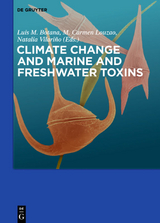Climate Change and Marine and Freshwater Toxins
De Gruyter (Verlag)
978-3-11-033303-9 (ISBN)
Prof. Luis M Botana, Prof. Natalia Vilariño and Prof. M Carmen Louzao, Universidad de Santiago de Compostela, Lugo, Spain.
Prof. Luis M. Botana, Prof. Natalia Vilariño and Prof. M. Carmen Louzao, Universidad de Santiago de Compostela, Lugo, Spain.
I - Introduction
1.- Extraterrestrial influences: links between solar and tidal variations and the weather
Saumitra Murkherjee, School of Environmental Sciences, Jawaharlal Nehru University, New Delhi, India
2.- The atmospheric circulation and ocean interactions
JM Slingo, Centre for Global Atmospheric Modelling, The University of Reading, Earley Gate, Reading RG2 6AR, UK.
3.- Variability and trends of the global sea ice covers and sea levels
Victor.Smetacek, Alfred Wegener Institute for Polar and Marine Research, Am Handelshafen 12, 27570 Bremerhaven, Germany.
4.- Dynamic marine and freshwater ecosystems
Victor Vasconcellos, CIIMAR/CIMAR, Laboratory of Ecotoxicology, Genomic and Evolution-Centre of Environmental and Marine Research, University of Porto, Rua dos Bragas 289, 4050-123 Porto, Portugal.
5.- Biodiversity of microorganisms in the context of climate change
David Lindenmayer, Fenner School of Environment and Society, The Australian National University, Canberra, Australian Capital Territory, Australia.
6.- Developing methods and tools for climate change impact assessment on toxins
Louzao, M. C, Dept. Farmacología, Fac. Veterinaria, 27002 Lugo, Spain.
7.- New techniques in environment monitoring
Anderson DM, Biology Department, Woods Hole Oceanographic Institution, Woods Hole, Massachusetts 02543, USA.
8.- Controling harmful cyanobacterial and algal blooms
Paerl HW Institute of Marine Sciences, University of North Carolina at Chapel Hill, 3431 Arendell Street, Morehead City, NC 28557, USA.
9.- Risk assessment and climate change
Moore MR, National Research Centre for Environmental Toxicology & Queensland Health Scientific Services, University of Queensland, Archerfield, Australia.
10.- Effects on world food production and security
Miraglia M, National Center for Food Quality and Risk Assessment, Italian National Institute for Health (ISS), Viale Regina Elena 299, I-00166 Rome, Italy.
11.- Spread of animal diseases as a consequence of climate change
Genchi C, DIPAV, Facoltà di Medicina Veterinaria, Università degli Studi di Milano, Via Celoria 10, 20133 Milano, Italy.
12.- Potential health impacts of climate change
McMichael AJ. National Centre for Epidemiology and Population Health, Australian National University, Canberra ACT 0200, Australia.
13.- Climate sensitivity of infectious directly and indirectly transmitted diseases
E. MIchael, Department of Infectious Disease Epidemiology, Faculty of Medicine, St. Mary's campus, Imperial College London, Norfolk Place, London W2 1PG, UK.
14.- From science to policy: international legislation on adaptation to climate change
Petticrew Mark, Department of Social and Environmental Health Research, London School of Hygiene and Tropical Medicine, London, United Kingdom.
II. Climate change and water toxins
1. Biology of marine toxin producing organisms and toxin production
Anke Kremp. Marine Research Centre, Finnish Environment Institute.
2. Biology cyanobacteria and toxin production
Elke Dittmann. Department of microbiology. University of Postdam. Germany.
3. Distribution of marine toxins: an evolving matter
Stephanie Hinder. Mike Gravenor. Institute of Life Science. Swansea University. UK.
4. Worldwide distribution of toxic cyanobacteria
Julianne Dyble. Great Lakes Environment Research Laboratory. Ann Arbor, MI, USA.
5. Global warming and harmful algal blooms.
Stephanie Moore. School of Oceanography , University of Washington, and NOAA, Northwest Fisheries Science Center, West Coastal Center for Oceans and Human Health.
6. Impact of global warming on cyanobacteria toxic blooms
Hans Paerl. Institute of marine sciences. University of North Carolina.
7. Increased frequency of HABs. Human activity or climate change related?
Deana Erdner. University of Texas.
9. Marine HABs and food quality prediction models
Peperzak L. National Institute for Coastal and Marine Management. The Netherlands.
10. Drinking water quality prediction models
Alex Elliott. Center of Ecology and Hydrology Lancaster. Lancashire, UK.
11. Control and management of HABs
Donald M. Anderson. Biology Department. Woods Hole Oceanographic Institution. MA.
12. Management of compromised drinking water safety
Michel Prèvost. École Polytechnique de Montreal, Civil, Mineral and Mining Engineering Department, Montreal, Quebec, Canada.
13. Seafood safety challenged by climate change
Lora Fleming. Department of Epidemiology & Public Health, University of Miami School of Medicine.
"The book is an excellent introduction to the complex topic of climate change and toxins in water. It is a useful resource for researchers working in environmental monitoring, ecotoxicology, and related fields. [...] The book can serve as useful guide for researchers working in environmental monitoring, ecotoxicology, and related fields."
Tamim Younos in: Anal Bioanal Chem (2016) 408
| Erscheint lt. Verlag | 28.8.2015 |
|---|---|
| Co-Autor | Katja Antilla, Dani J. Barrington, Hugo Borges, Liah X. Coggins, Josefine C. Comiso, Daniel R. Dietrich, Begona Espina, Joaquin Espinosa, Hazel Farrell, Maria Fraga, Paulo P. Freitas, Oscar Garcia-Martin, Anas Ghadouani, Gustaaf M. Hallegraeff, David P. Hamilton, Uwe John, Panagiota Katikou, Gurjeet Singh Kohli, Anke Kremp, Veronica C. Martins, Shauna Murray, Mikko Nikinmaa, Marta Prado, Elke S. Reichwaldt, Jose Rivas, Sara Silva-Salvado, Som Cit Sinang, Stephanie Vial, Aristidis Vlamis, Susanna Wood, Xi Xiao |
| Verlagsort | Berlin/Boston |
| Sprache | englisch |
| Maße | 170 x 240 mm |
| Gewicht | 970 g |
| Themenwelt | Studium ► 2. Studienabschnitt (Klinik) ► Pharmakologie / Toxikologie |
| Naturwissenschaften ► Chemie ► Analytische Chemie | |
| Schlagworte | Analytische Chemie • climate change • Drinking Water Safety • Food and Feedstock • Freshwater Toxins • Klimaänderung • marine toxins • Marine Toxins, Freshwater Toxins, Drinking Water Safety, Food and Feedstock, Climate Change, • Marine Toxins,§§§Freshwater Toxins,§§§Drinking Water Safety,§§§Food and Feedstock,§§§Climate Change, • Meeresbiologie • Toxin |
| ISBN-10 | 3-11-033303-1 / 3110333031 |
| ISBN-13 | 978-3-11-033303-9 / 9783110333039 |
| Zustand | Neuware |
| Haben Sie eine Frage zum Produkt? |
aus dem Bereich




